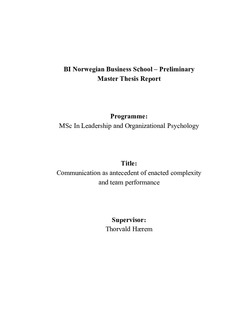| dc.description.abstract | Building on recent theoretical and methodological developments in
organizational studies focusing on organizational routines (Hærem, Pentland and
Miller, 2015; Hansson, 2018), this thesis aim to explore how three aspects of team
communication; Frequency, distribution of communication and use of
achievement-oriented language, influence team performance, and if enacted
complexity mediates this relationship. The study relies on data gathered from 106
teams, solving a team task in the crisis simulator MindLab. The results of our
analysis indicate a positive relationship between the frequency of communication
and team performance, and that this relationship is fully mediated by enacted
complexity. Further, achievement-oriented language was found to positively
correlate with team performance, but this relationship was not mediated by
enacted complexity. These findings suggest that we have identified two separate
mechanisms governing the relationship between communicative aspects and team
performance as we find support for the mediating role of enacted complexity
between communication frequency and performance, while achievement oriented
language and performance are correlated, but seems uncorrelated with enacted
complexity. We found no statistical support for a relationship between team
members’ distribution of communication, enacted complexity and team
performance. Due to the findings, this study extends the organizational routines
literature by supporting earlier findings of a positive link between enacted
complexity and team performance, in uncertain task environments. Further, this
research identifies enacted complexity as a mediator of the relationship between
communication frequency and performance, and strengthens the argument for
routines as a potential source of flexibility and advantage when performing tasks
in uncertain environments. | nb_NO |

